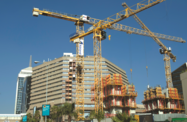Growth in trading density – a measure of turnover per sq metre of retail space – for South Africa’s larger malls has lagged behind that of smaller shopping centres, in part a reflection of the country’s slowing economy and the rapid increase in the number of dedicated retail properties.
Market trends
A recent index by South Africa’s Investment Property Databank (IPD), a subsidiary of US-based research firm MSCI, found that while trading density rose year-on-year (y-o-y) in the second quarter of 2016 for all retail complexes, smaller community malls and neighbourhood outlets both outpaced larger malls.
According to the IPD South Africa Retail Trading Density Index, community malls posted an 11.9% jump in trading density y-o-y, with neighbourhood outlets up 8.8% and small regional malls recording a 6.6% rise in the period.
By contrast, super-regional malls – those with more than 100,000 sq metres of leasable space – and large-scale regional malls saw trading density increase by 6.4% and 5.7% y-o-y, respectively.
The strengthening performance of smaller retail spaces when compared to mega-malls or upscale outlets has been an ongoing trend.
At the end of last year, for example, the IPD index showed trading density at community centres increasing by 8.7%, small regional centres by 6.2% and regional shopping centres up 5.6% all outpacing their larger competitors on 4.9% growth.
Top-end oversupply
The softening growth for larger properties is in part a reflection of greater competition.
While there is still demand for space in larger centres, the rise in the overall leaseable floor space in the segment is intensifying competition for customer footfalls and revenue.
The launch of new malls in a number of major urban centres is putting pressure on existing retail centres as the market becomes oversupplied, according to Keillen Ndlovu, head of listed property funds at Stanlib, a Johannesburg-based asset management firm.
“We expect a further slowdown in trading density growth and footfall given the slowing economy and cannibalisation of retail spend, especially among bigger shopping centres,” he told local media at the end of September.
Larger upmarket outlets are also being affected by continued weak consumer sentiment – only 22% of South African shoppers are in a buying mood, according to third-quarter data from the Nielsen consumer confidence index, in which the country has slipped from seventh to eighth out of 26 African markets.
Such trends could lead to a curbing of discretionary and entertainment spending, though smaller centres focusing more on essential goods may feel less of a pinch.
With some 70 new large-scale malls either already under construction or due to break ground by 2018, the mega-mall and regional mall segments will become further saturated, adding to competition at the upper end of the market.
For example, the R950m ($66.6m) Springs Mall currently under construction will be the first major mall in Springs, Gauteng upon completion in March 2017. The 48,000-sq-metre shopping centre is a joint venture between Blue Crane Eco Mall, Flanagan & Gerard Property Development & Investment, Vukile Property Fund and Murinda Investments.
In anticipation of the mall’s opening, 96% of the space has already been leased to national retailers such as Woolworths, Checkers, Pick n Pay and Edgars.
Additionally, local property firm Accelerate Property Fund recently began construction to add 90,000 sq metres to Johannesburg’s Fourways Mall for a total of 175,000 sq metres under one roof, according to press reports from April.
Once the R30m ($2.1m) renovation is completed in mid-2018, Fourways Mall will be larger than South Africa’s newest mega-mall, Mall of Africa, which covers 131,000 sq metres and opened its doors in Waterfall City, Gauteng in late April.
South Africa’s market is already among the most well supplied in terms of retail property – its 23m sq metres of leasable area land it in seventh place globally, with another 2m sq metres in the development pipeline, according to Urban Studies, a Johannesburg-based real estate research firm.
Though the large-scale end of the retail property sector may be over-serviced in the short to medium term, investment potential remains.
As urbanisation increases in South Africa, and communities continue to grow away from major population centres, there will be further space for expansion in the smaller community and neighbourhood segments of the retail property market.
Oxford Business Group is now on Instagram. Follow us here for news and stunning imagery from the more than 30 markets we cover.

